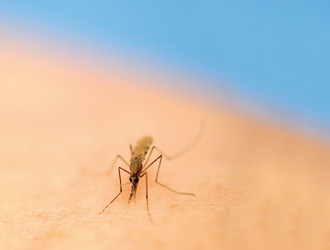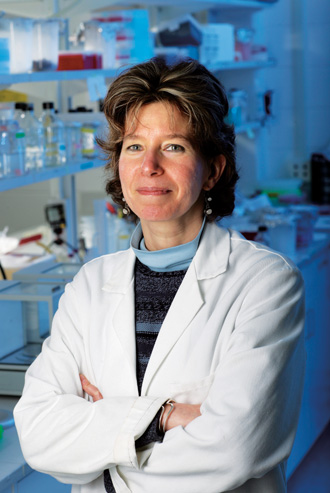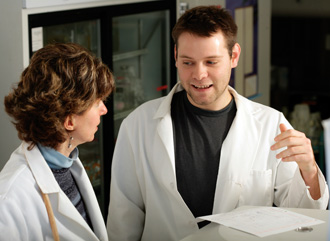Oberlin Alumni Magazine
Winter 2008-09 Vol. 104 No. 2
Taking a Bite out of Malaria


Molecular biologist Nora Besansky didn’t want to become "a biology nerd" at Oberlin, but the lure of malaria research was too great to resist. Now she runs a nationally renowned genetics laboratory where researchers are paving the way for "genetically engineered mosquitoes" that could one day stop the devastating disease in its tracks.
In the summer of 1986, a graduate student at Yale University walked into a campus genetics laboratory and got the surprise of her life.
Staring at a sheet of laboratory film, Nora Besansky ran her eyes over the series of dark and light bands. This can’t be accurate, she told herself. There must have been a mistake.
But the pattern of horizontal bands on the Southern Blot DNA test was crystal-clear: Besansky had finally located a key segment of DNA in the genome of one of humankind’s deadliest enemies —a malaria-carrying mosquito.
Her pulse racing and heart hammering, the young geneticist realized that she’d just struck scientific gold.
After hundreds of fruitless laboratory tests stretching back two years, Besansky had at last pinpointed a group of "transposable elements" in the genetic makeup of the Anopheles gambiae mosquito—a brutally effective disease host that kills more than 1 million African children each year by infecting them with malaria.
For Besansky, a 1982 Oberlin biology graduate, the memory of that breakthrough still burns with a fiery radiance.
"That was one of those ‘I-could-have-died-on-the-spot’ happy moments that a scientist never forgets," she says. "Up until that moment, no one had ever identified a family of transposable elements in that mosquito, and searching for them proved to be extremely difficult. I’d been working on it for several years, and I’d been getting negative results over and over again.
"After so many failures, I’d assumed that the next batch of tests I sent out would come back negative, too. But then, when I looked at the Southern Blot film … well, that was the most beautiful thing I’d ever seen, and nothing has ever quite equaled that moment of discovery."
Searching for a tool against malaria
Ask Besansky—now a 48-year-old veteran molecular biologist at Notre Dame University—why she became so excited that long-ago morning, and she’ll quickly launch into a mini-lecture on the complex subject of "population genetics" in malaria-transmitting mosquitoes.
"The key thing to understand is that transposable elements occur in all living creatures," says Besansky with the easy eloquence of a born teacher. "They are simply pieces of DNA that know how to move around inside chromosomes and reproduce themselves. And these highly mobile elements can move from one part of a mosquito’s genome to another, and also from one group of mosquitoes to another."
Transposable elements, she says, are interesting in their own right. "But what’s really cool is that they have the potential to help us create a mosquito that no longer transmits the most lethal form of malaria, but instead, kills it."
To understand how such a transgenic mosquito would work, it helps to think of these transposable elements as a genetic copy machine that knows how to endlessly replicate itself within a mosquito’s genome. Because the organic fragments that make up this self-replicating DNA can jump from one mosquito to the next—and then "turn on the copier" to replicate themselves in huge numbers—malaria fighters have long dreamed of tagging them with an inserted gene that could interrupt the life cycle of the malaria parasite in the mosquito.
How would the strategy work? The biochemistry is complex, but the concept is simple, says Besansky. After creating a "genetically engineered" version of the An. gambiae mosquito (by far the most common transmitter of the disease in Africa, where most deaths occur), the scientists would release it in areas most affected by the parasite. Once dispersed into the world, and now "armed" with the extra malaria-killing gene, the transgenic insect would gradually spread its anti-malaria parasite DNA throughout millions and then billions of African mosquitoes.
The bottom line: because human beings catch malaria when bitten by mosquitoes that carry the parasite in their saliva, adding the anti-malaria parasite gene to the genome of the insects (known as the "disease vectors") would eventually break the cycle of transmission.
Although the creation and dissemination of such malaria-fighting mosquitoes is probably 10 to 20 years away, there’s little doubt that transposable elements could play a key role in making it happen.
"What I found in the Yale lab that day was a basic tool that could someday help shut down malaria," says Besansky, who now teaches genetics and runs her own malaria vector lab. And while she’s careful to note that the particular family of elements she discovered (the "T1 Retrotransposon Family") lacks the genetic mobility to serve as the eventual anti-malaria copy machine, she still basks in the glow of having discovered the first-ever such elements in An. gambiae.
"I feel very fortunate that I was able to pinpoint another tool in the ongoing struggle against the disease," she says. "I went to graduate school after Oberlin with the express intention of finding that tool, because I knew it might someday help in malaria research."
Understanding how mosquitoes adapt
These days Besansky’s work focuses mainly on learning how different species of mosquitoes are able to mutate genetically so they can quickly adapt to changes in their environment, especially land-use changes such as deforestation, rice farming, and intensive agriculture.
With that knowledge, Besansky hopes scientists of the future will be better equipped to create malaria-fighting, transgenic mosquitoes that can’t so easily dodge our ways of fighting back. "The only real tool we have for malaria control today is insecticide-impregnated bed nets," she explains. "They still work well because most malaria vector mosquitoes are still susceptible to insecticides, and even more importantly, most bite indoors at night, when humans are safely sleeping under the nets.
"But if we’ve learned anything in recent years, it’s that these mosquitoes change and adapt very quickly. Even scarier, they can change their biting behavior. They could conceivably start biting during the daytime when people are up and about. What then?"
To prevent mosquitoes from mutating and rendering such weapons useless, says Besansky, it’s important to understand the genetic basis of such adaptations, especially in Africa. "I’m in this for the long haul," she vows. "My lab is interested in understanding the genetic basis of how these different mosquito populations adapt."
Born and raised in the Washington, D.C., area, Besansky landed at Oberlin in 1978. "I’d grown up in a liberal Democratic household, and for me, Oberlin fit that mold perfectly," she says. "It was small and down to earth—not like some of the Ivy League schools where things tended to get pompous at times."
Although she soon found herself drawn to biology—"I remember sitting through one of [retired biology professor] Dennis Luck’s fascinating lectures on gene sequencing and asking myself what it all meant"—Besansky says she was dead-set against becoming "the kind of biology nerd that I am now!"
"I got good grades, I guess," she recalls (and without mentioning that she was a Phi Beta Kappa), "but I wanted no part of becoming a ‘star biology major.’ So I took the bare minimum of required biology courses. Meanwhile, I was taking tons of other stuff—history and music and magical realism in Latin-American literature. I was all over the place.
"I wanted to learn about art, culture, you name it. And I got a terrific opportunity to do just that, after I signed up for a semester-abroad program that let me study mosquito ecology in Costa Rica."
After earning her biology degree, Besansky took a job as a technician in a research laboratory at the National Institutes of Health. Within a year, she was hooked on molecular genetics and wound up at Yale, where she spent six years working on transposable elements in An. gambiae before a six-year stint as a staff scientist at the Malaria Branch of the Centers for Disease Control and Prevention in Atlanta.
As her research on mosquito genetics and malaria took off, Besansky was recruited by the biology department at Notre Dame. For the past decade, she’s taught genetics to undergrads and supervised a dozen technicians, graduate assistants, postdoctoral fellows, and full-time researchers in her own highly specialized lab in Notre Dame’s Center for Global Health and Infectious Diseases.
"When you take a look at what a disease like malaria does to people—especially in impoverished regions—it’s easy to find the motivation to get back into that lab and keep working."
Quiz Besansky’s colleagues about her contribution to scientific research, and they’ll often point out that she’s doing both basic and applied research. "What’s really cool is the way she’s asking basic questions related to molecular genetics, but she’s doing it by focusing on the genome of an insect that makes people sick," says Notre Dame Biology Professor Jessica J. Hellmann, who specializes in the ecology of grasslands.
"Nora is involved in pure research, even as she applies it to helping win the battle against malaria. She’s also a terrific teacher."
While directing the daily research in her lab, Besansky has also produced a steady stream of scientific papers and journal articles, a fact that was cited by the American Association for the Advancement of Science (AAAS) in 2005, when she was selected to become an AAAS Fellow. At the Johns Hopkins University Malaria Research Institute, one of the country’s foremost centers for studying the disease, malaria researcher Sean Prigge says that Besanky’s work on the population genetics of African mosquitoes seems likely to play a vital part in someday controlling—and maybe even eradicating—malaria in Africa.
"From my vantage point, her approach looks like it will provide us with an exciting tool that we can ultimately use as part of a widespread eradication program," says Prigge. "Malaria is a formidable opponent, and I’m glad that Nora is out there working on mosquito genetics. We’re going to need every tool we can get."
So how does Besansky maintain the frenetic pace required for teaching, researching, publishing, editing scientific journals, and winning research grants (she’s currently operating her lab with $2.5 million in funds from the National Institutes of Health) while also helping to raise two teenage sons?
"When you take a look at what a disease like malaria does to people—especially in impoverished regions in Africa—it’s easy to find the motivation to get back into that lab and keep working." She means it, too. Ask her husband of 27 years, Frank Collins, a veteran tropical disease researcher and Clark Professor of Biology at Notre Dame, about her work habits, and he’ll tell you that she "works harder than anybody I know, and she’s also a far better scientist than I am."
Although Besansky feels optimistic about the long-term future of malaria control in Africa, she tells her students that wiping out Plasmodium falciparum (the most common form of the disease) won’t happen anytime soon. "This microbial predator has proved to be exceedingly good over time at using its genetic plasticity to dodge every bullet we fire at it."
For example, to avoid detection by human antibodies, the parasite employs the effective strategy of constantly altering the structure of the proteins it deposits on cell walls it attacks, effectively camouflaging itself at the molecular level. By employing these "camouflage" proteins, the parasite can often avoid detection by the immune system, then wreak havoc as it literally "drinks the blood" of its victims, cell by cell.
Another powerful strategy employed by the bug is a technique known as "sequestering," in which the invading parasite glues itself to tiny blood vessels and remains motionless for days at a time. This way, it avoids passing through the body’s spleen, where antibodies prowl night and day in search of microbial trespassers to kill.
"There’s no doubt that this is an extremely capable adversary, and it’s tragic to witness the suffering it causes each day, especially in Africa," says Besansky, referencing recent studies by the World Health Organization that suggest that malaria kills a child somewhere in the world every 30 seconds.
"I’ve seen estimates that as many as 3 million people are dying each year from malaria," she sighs. "And it’s very painful to admit, but the work we’re doing on mosquito population genetics in this lab right now isn’t going to save those 3 million, or the 3 million who will die next year.
"All we can do is wake up in the morning and work very hard, so that someday, whether it’s 10 years or 50 years from now, this terrible disease will finally be eliminated from our world."
Tom Nugent is a freelance writer in Michigan and a frequent contributor to OAM.
 Nora Besansky and Brad White
Nora Besansky and Brad White
Brad White: Warrior Against Malaria
He spends his days—and more than a few of his nights—perched above a giant 3730 XL DNA analyzer, where he searches tirelessly for a chink in the genetic armor of one of humankind’s most lethal enemies: the malaria-spreading An. gambiae mosquito.
"Analyzing genetic data from mosquitoes can get pretty complicated at times," says Bradley J. White ’04, a PhD student in Nora Besansky’s malaria vector research lab at Notre Dame University, "but I actually enjoy the complexity.
"For this kind of work, you need good critical thinking skills, since you’re often being challenged to find explanations for genetic processes that are very difficult to untangle. The other night I wound up working here in the lab until 2 a.m. I didn’t mind staying up late, because I was able to track a chromosomal inversion [genetic anomaly] by sifting through tons and tons of genetic data.
"I wound up with a beautiful Bell curve on the graph I made…and also with some exciting findings about inversion and genetic plasticity and how they might play a role in the way mosquitoes transmit malaria."
A native of Tampa, Florida, White double-majored in biology and English at Oberlin. While studying the ecology of the West Nile virus, writing a thesis on the works of contemporary Irish poet Eavan Boland, and playing on several Oberlin tennis teams, he took a plunge into hard-core scientific research and signed on for a summer job as a research assistant to Associate Professor of Biology Mary Garvin. That job led to his current post as a lab tech and genomics researcher in Besansky’s malaria lab at Notre Dame.
The Public Library of Science Genetics recently published some of his findings and now White says he can’t get enough of the high-tech lab where he logs so many hours. "I’ve spent most of my career working with this machine," he notes, while giving the stainless steel case of his 3730 XL an affectionate pat.
"I’ve probably looked at more than a million base pairs in the mosquito’s genetic code by now, and yet I keep making new connections and coming upon insights almost every day."
He was also motivated by a recent malaria research project in Cameroon, where he witnessed some of the horrendous effects of the disease on suffering human beings.
"I went into a hospital in a Cameroonian village," he recalls, "and they showed me their medical supplies. They didn’t really have anything more than I have in my own house—stuff like Band-Aids and aspirin, and not much else.
"In many parts of Africa, disease and poverty are everywhere. And yet you also find this amazing joy in living and this amazing sense of hope, especially among the children. I returned to the lab feeling energized and ready to get back to work!"
